November 2012
 |
We don't
come across a special card often enough to have a "Card of the
Month" section, but we'll keep using the intro space of the
"Deck of the Month" xpo every time we find a special one.
This card came in an incomplete deck by the Vereinigte Stralsunder
Spielkartenfabriken from around 1890. |
|
It was
found at the Jaarbeurs during the largest collectors fair in the
Netherlands, that is held there twice a year. Usually we don't buy
partial decks, but this one had a set of illustrated aces, that is not
often seen with the standard Frankfurt pattern by this company. And it
also held this 7 of Hearts. It was this card that tipped the scale and
we bought the pack, just because we had never seen a stamp like this
before. The deck was apparently made for export to the Netherlands (or
the Flemish part of Belgium), as the text is clearly in Dutch. |
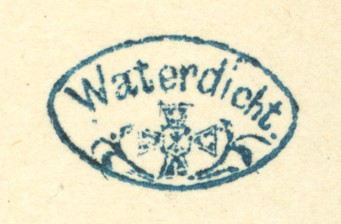
|
|
"Waterdicht"
means waterproof and underneath is the company logo of the VSS, so it can
be seen as a company quality mark. And a remarkable one, as it's hard to
imagine in relation to playing cards. Second to fire, water is disastrous
for any paper or card. So naturally we were tempted to put this claim to
the test. As the deck was incomplete anyway, we used one of the other pips
for this.
The result? When the card had been in a spot of water for 2 minutes,
it would curl up and -after drying it with a tissue and pressing it by
hand- that curl didn't completely disappear. Although almost mint, we
"cleaned" an other card with a soaking wet cloth, but that hardly
left any visible distortion. So the "waterdicht" here is a
waterproof statement! |
So far this month's unusual card, now for the regular intro.......
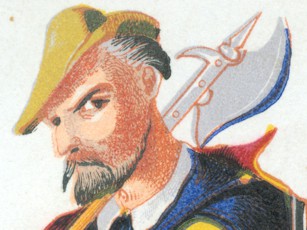 |
Just
like October, it was a busy month. Joop turned 61 and we celebrated our
28th wedding anniversary on that same date. The next day we had to get
up early for the first day at the Jaarbeurs, so no big party, just an
intimate dinner à deux in a nice nearby restaurant.
The first weekend there was the Van Spee collectors bourse, for the
first time at its new location in Nieuwegein. We found some good decks
to trade, but nothing really special for our own collection. The main
event however was the largest collectors fair at the Jaarbeurs in
Utrecht from the 23th to 25th. Always a source of some unexpected finds
and this time wasn't any different. Besides some very interesting decks
to trade we picked up the Schwerterkarte by Wüst from around 1900 and
the first edition of Dondorf's Rhineland pattern from 1870, both in
excellent condition. We should also mention the cute vintage miniature
advertising deck with a never seen fantasy pattern, probably from the
1930's. French or maybe German, we still have to research that.
Of course Ebay was a good source too this month. We could finally add
the original "Surrealist" deck by Leonor Fini from around 1950
to our collection, just like the 1896 Stage 65 X deck (thanks again,
Larry!). |
|
And to
complete this month's very interesting short list we shouldn't forget to
mention the "Boston No.47" deck by Müller, probably from the
1920's, nor the early version of the Cartes Hollandaises by Grimaud from
around 1890. But none of them held this sharp portrait of a Jack in its
Spades suit. |
The portrait didn't tip the scale, but the fact that we had a
hard time finding any reference to the deck did. We had thought
that we would find it in the Cary collection or at least in John Berry's
Playing Cards of the World, describing the Guildhall collection, but it
wasn't in either. So we checked all the Cartorama catalogues that we
have here, but it also wasn't in any of them. The only reference that we
found was in the Fournier catalogue and it wasn't a very elaborate one:
British Isles # 310 (page 226) "Fantasy deck of 52 cards with
French suit markings and continental-type reversible court cards for export to
Paris. Made by THOMAS DE LA RUE, London 1890." There's not much else
that we can add to the Fournier description, except that the cards were printed
in chromolithography.
The deck must be a rarely seen one, as this was the only description we
could find. So a good reason to share it here with you.
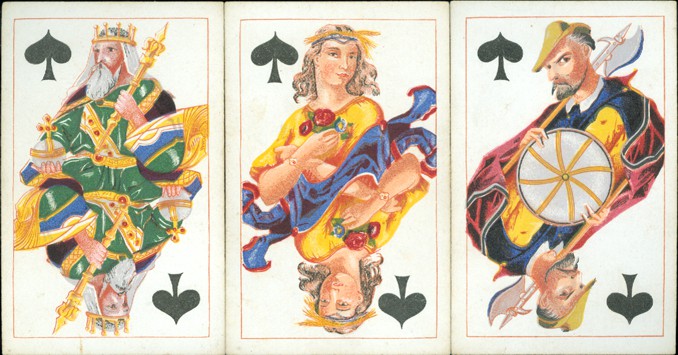
But of course there's
something to say about the artwork. Almost all the robes and dresses are all
well drawn, but looking at the faces there's a significant difference in
quality. The Jacks all have a well drawn, natural look. Taking that quality as a
standard, then the Kings overall seem to lack that the most. Unnatural red
cheeks (KH) or a bit artificial facial hair don't help. In the Queens there's a
great difference in quality. Where the QS has fine detailed facial expressions
and a natural pose, the QC looks flat and -maybe because of her darker tone,
together with that feather- reminded us more of a dressed-up Indian squaw than
royalty. For us she's the worst drawn figure in the deck.
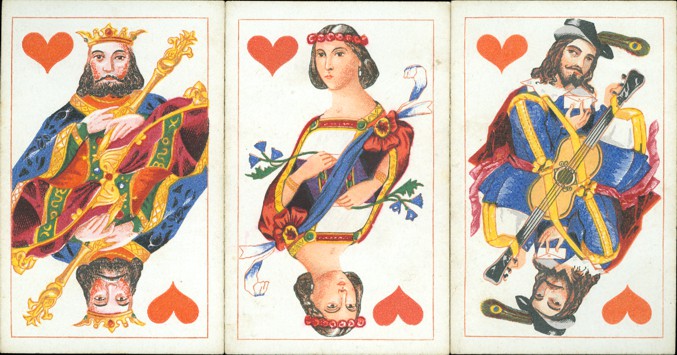
It's hard to
imagine that one artist can produce such vivid Jacks and such a flat Queen.
Sometimes it helps to look at the hands. These are one of the most difficult
body parts to capture and sometimes they reveal a different approach. In these
drawings there are thin, pale, bony fingers as well as rich full ones. But we
don't want to jump to conclusions, solely based on fingers. There's just one
more detail that struck us. In the Spades suit the faces of the Queen and Jack
have about the same proportions, but the head of the King is a bit smaller and
this gives the impression that the whole figure somewhat in the background, when
the cards are placed together, as above.

It's the first Ace
of Spades by De La Rue, that we've seen, which carries the name of Paris too.
They had a "depot" and probably a sales office too on the Rue du
Chateau d'Eau 52 in Paris.
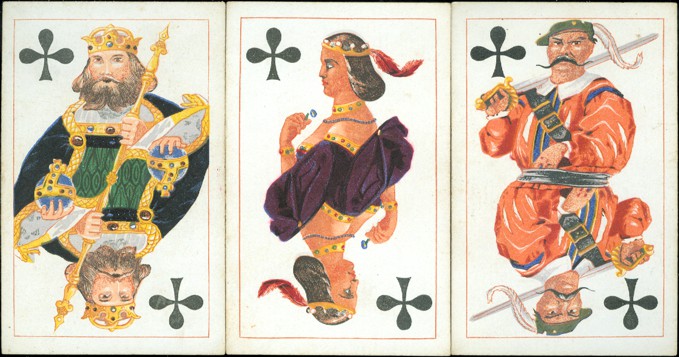
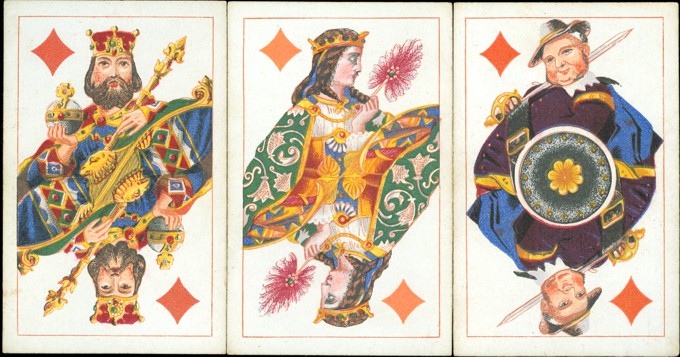
We joined in on
Facebook in October 2016 and soon were invited to become a member of the Playing
Card Collectors group. It has proven itself as a source of information and in
March 2017 the following information about this deck turned up: in the IPCS
Journal Vol. 34 nr. 1 (July/Sept. 2005) Michael Cooper wrote an interesting
article about this pack and its successor. This deck here was mentioned in an
article from "The Stationer and Fancy Trades Register" of September
1867. In De La Rue's trade catalogue for 1868/69 these decks were advertised as
"French Moguls" and "Harrys" at a trade price of 16
shillings for the Moguls and 13 shilling for the Harrys. So we can conclude that
the Fournier catalogue was a bit off in their dating and that this deck was
published in 1868.
BACK TO PRESENT MONTH







